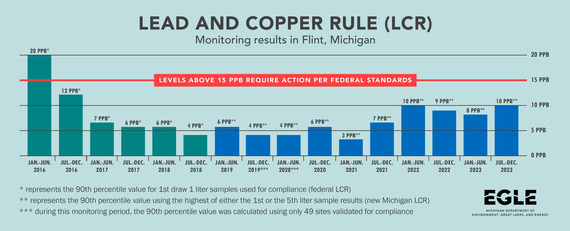|
FOR IMMEDIATE RELEASE
Dec. 18, 2023
EGLE Media Office, [email protected], 517-284-9278
Flint marks more than seven years of compliance with lead standards
Twice yearly testing shows lasting impact of water infrastructure improvements
The Michigan Department of Environment, Great Lakes, and Energy (EGLE) today announced that the City of Flint?s Lead and Copper Rule (LCR) monitoring has shown the 90th percentile for lead to be 10 parts per billion (ppb). This result marks seven-and-a-half consecutive years that the city?s water has met the requirements of the Safe Drinking Water Act.
Since July 2016, the city of Flint?s water system has tested below action levels for both lead and copper during 15 consecutive monitoring periods. The latest six-month monitoring period from July 1, 2023, through Dec. 31, 2023, resulted in a 90th percentile calculation for the samples collected of 10 ppb for lead. This includes Michigan?s stricter-than-federal requirement that a fifth liter sample be collected to better reflect the impact of lead service lines. ?
The 90th percentile calculation of 10 ppb means 90 percent of the test results used in the calculation came in at or below 10 ppb. The latest testing result is higher than the previous 6-month period result of 8 ppb for lead and remains below the federal action level of 15 ppb.?
Test results from 31 residences (Tier 1) and 30 commercial properties (Tier 2) served by lead service lines, showed three sites above the 15 ppb action level. Testing revealed that two of these results were collected from the first liter samples taken from Tier 1 sites indicating that aging interior plumbing was the source of the exceedance.
Tier 2 sites make up a growing portion of Flint?s water sampling pool as more than 95 percent of residential sites have had their lead service lines replaced. If only the 31 residential sites had been used in the calculation, the result would have been 6 ppb. All sites were notified of their results and actions were taken to reduce exposure.
?As Flint nears eight consecutive years of compliance with Michigan?s strict Lead and Copper Rule, the data clearly shows that the modernized water system is consistently supplying high-quality drinking water to city residents,? said Eric Oswald, director of EGLE?s Drinking Water and Environmental Health Division. ?The challenge remains modernizing household plumbing and encouraging more regular water usage at businesses to drive these lead detections even lower.?
Strategies to reduce lead exposures in the home can be found on the State?s Mi Lead Safe web site.
Michigan in 2018 adopted the nation?s toughest lead rules for drinking water. The state?s Lead and Copper Rule (LCR) requires that all lead service lines in the state be removed. Water supplies are required to replace an average of five percent of their lead service lines annually over a 20-year period that started in 2021. Starting in 2025, the rule lowers the action level to 12 ppb.
Flint?s testing results can be found by visiting the State?s Flint Water website. Additional information about Michigan?s new testing requirements and results state-wide can be found at Mi Lead Safe.
 ###
|